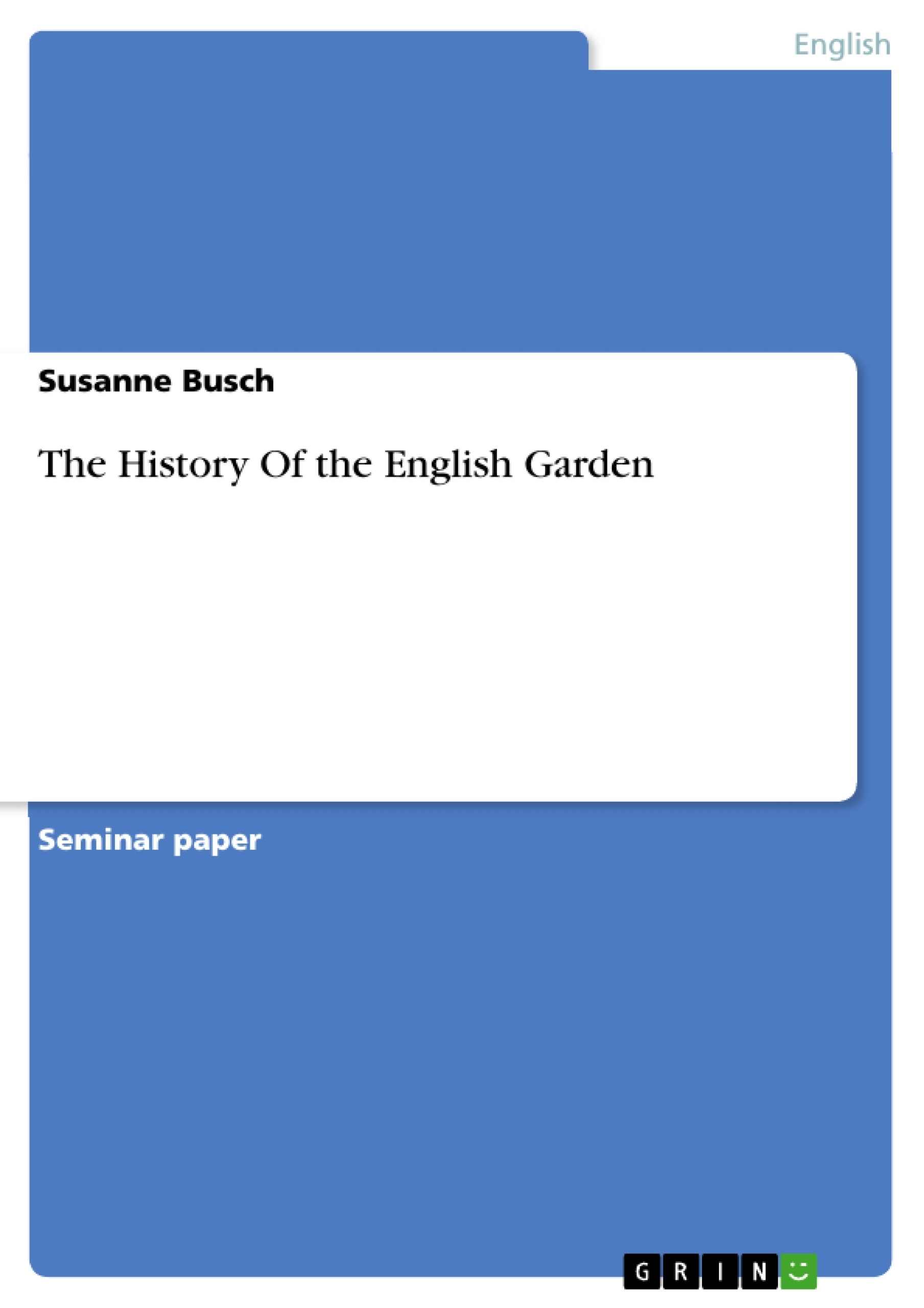Excerpt
Table of Content
1. The Fascinating English Garden
2. The History of the English Garden
2.1 The Renaissance Garden in England
2.2 The Baroque and Rococo Garden in England
2.3 The English Landscaped Garden
2.4 English Garden Theories in the 18th and 19th Century
2.5 The Victorian or Formal Garden
2.6 The Garden during the Arts and Crafts Movement
2.7 The Modern Garden
2.8 The Continuance of the Classical Garden
2.9 The Twentieth Century
Bibliography
1. The Fascinating English Garden
The Fascinating English Garden
In no other country in the world are more gardens open to the general public than in England. There is both a huge variety of styles and a big selection of plants. The list of international well-known gardens is long. Gardens like Sissinghurst and Stourhead show the special character and greatness of the English Garden; however, each garden has its own flair and expresses the sometimes quite eccentric personality of the owner or creator. Besides, in England a person who renders gardening a great service gains honour and fame.[1] For many gardening is more a prestigious rather than plainly a leisure activity. The art of the garden plays an important role in English society in general.
The garden authority with the most influence is the “Royal Horticultural Society”, which has nearly 250,000 members. The garden festivals they arrange are popular social events.
Moreover, the National Trust is a famous and very important institution concerning conservation work. The full name stands for the principles of this charity: “The National Trust for Places of Historic Interest and Natural Beauty”. One aim of their work is to care for over 230 gardens in Great Britain.
Apart from this, Britain has a very favourable climate. Frost-free zones for tropical plants as well as cold and windy weather can be found in only one county – e.g. in Cornwall. That makes it possible to get so different impressions of a landscape in a small part of the country and the climate meets the requirements for the 120,000 different species of plants growing in British gardens.
The vividness of the English garden history in the present art of garden is remarkable. Many ideas were taken over from former garden styles like planting lavender, rosemary and ivy which were all brought to England by the Romans and can be find in all gardens today.[2] Maybe the typical English garden like the continental people might see it is the English Landscaped Garden, which is the English contribution to the garden history.
The recent head gardener of the Trelissick Gardens (National Trust), Barry Champion, may answer the question why the English people of all nations are famous for their love of gardens. He thinks that there is a difference in the art of gardening for example between the Germans and the English. If there was an old and ill tree in a garden, the German gardener would dig it up and throw it away and then would plant exactly the same kind of tree on the same place in the garden, while the English gardener would plant any kind of tree somewhere around the old one and would probably write a daily report about the course of the illness of the historic example. Barry Champion also believes that the “spirit” and the “feeling”, i.e. the ideas expressed, are the most important things in gardening and not the geometrical order or the historic plans. That is what the garden is or should be for: to every person, no matter which age or plane of consciousness they belong to, it is something magic and encouraging, because a garden is a place of energy and sensuality that invites people to pause and are, therefore, maybe more important as never before.
2. The History of the English Garden
The History of the English Garden
The English Garden History can be traced back to the Romans. However, it had gone nearly parallel with the development of the garden art of the other European states until the English Landscaped Garden took shape. Ideas and inspiration came from Italy and France.
2.1 The Renaissance Garden in England
The period of the Renaissance began in England with the Early Tudor Style. The first famous gardens were created under Henry VIII: Hampton Court (London) and Nonsuch. One thing was very popular in the Tudor’s era: the Gazebo (from English ‘gaze’). This is the name for a lookout pavilion, from where could be seen the castle and the garden; and often a wide view of the surrounding landscape pleased the courtiers. For instance Henry VIII had a hill built, specially for his Gazebo in Hampton Court.
Having an ornamental or a kitchen garden was also famous for this time. The ornamental gardens mostly were knot gardens, which were copied from the Italian and sometimes from the French model. But the English gardeners developed a specific type of this knot garden and kept up with this tradition until the 17th century.
The English Renaissance Garden has much similarity with the Italian one that looks at the garden as an architectural object. The symmetric adjustment on the castle or the Manor was not as important as the own architectural structure of the garden, which consist of walls, portals, towers, pavilions and stairs. These elements form the characteristic terraced grounds and also set the borders around the gardens.
[...]
[1] K. Walter, Gärten in Südengland (Köln: DuMont, 2000), p. 10 (Foreword by Anja Maubach)
[2] R. Herling, Klassische englische Gärten des 20. Jahrhunderts (Stuttgart: Eugen Ulmer, 1994), p. 10
- Quote paper
- Susanne Busch (Author), 2001, The History Of the English Garden, Munich, GRIN Verlag, https://www.grin.com/document/59185
Publish now - it's free























Comments